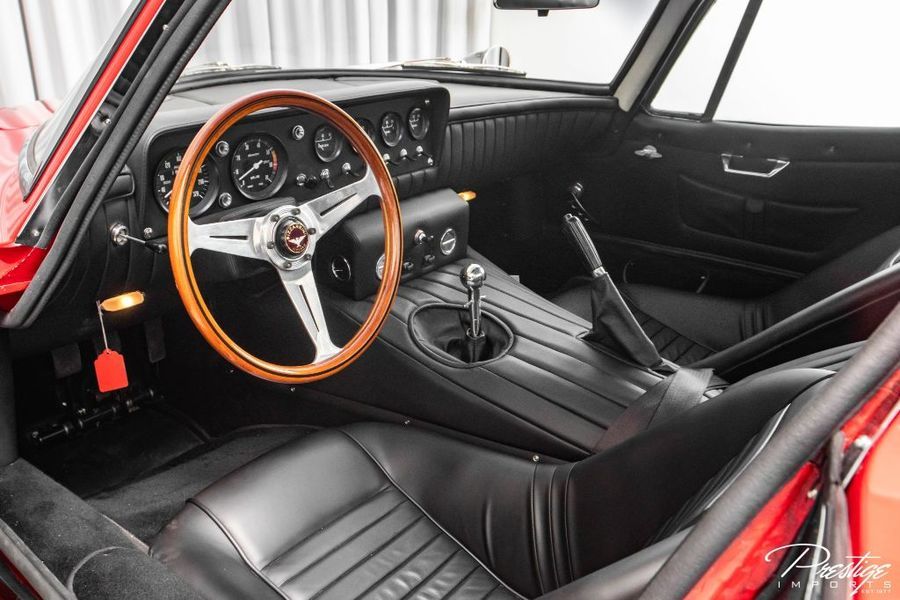Though it sounds like a menu in an Italian restaurant, the Bizzarrini Strada is a real car, and there’s no shame in admitting you’re hearing this name for the first time. The classic car enjoyed a rather short lifespan, having come to life in 1964 only to go belly up five years later. The accidental Italian marquee was declared bankrupt in 1969, and with it came the end of Bizzarrini automobile manufacturing.
What do we mean by "accidental marquee?" If the Ferrari Night of the Long Knives hadn’t happened, Giotto Bizzarrini wouldn’t have abruptly left his job as Chief Engineer at Ferrari. And if he hadn’t left, he wouldn’t have founded his own automobile manufacturing company. As Bizzarrini would later learn, start-your-own-business is all good and dandy so long as it isn’t based on emotional decision-making.
The Ferrari Night of Long Knives refers to Bizzarrini’s quarrel with Enzo Ferrari, leading to the head engineer’s departure with four Ferrari employees.
The new company’s tenuous existence wasn’t for lack of experience on the part of its founders. Bizzarrini’s engineering partners were Ferrari alumni, and Giotto himself had worked at Alfa Romeo, Lamborghini, and Ferrari. A colorful resume like that held a promise of assured success. And so the Strada was born, the first child of Bizzarrini S.p.A, and the poster child of defiance.
The Bizzarrini Strada In Detail
Bizzarrini Strada was a grand tourer which is why the car was also known as the 5300GT Strada. Naturally, Bizzarrini focused on building sports cars fueled by his experience at Ferrari. So, Strada was a low-slung 2-passenger sports car offered in roadster, coupe, and Corsa (track-tuned racer) trims.
The Strada was the most successful of the few models the company was able to build before succumbing to bankruptcy. Bizzarrini didn't have the time to make a lot of cars, but the few it did make were beyond nifty, especially the 5300GT Strada and the P538S. Meanwhile, as Bizzarrini wasn’t one to stay idle, he kept building cars for other brands, including the Iso Grifo for the automobile manufacturer Iso Autoveicoli S.p.A.
So, it's only natural that Bizzarrini built Strada on the Iso Rivolta IR 300 platform. In the four years of production, Bizzarrini’s company built 133 Stradas. The Strada sports grand tourer was a mid-engined rear-wheel drive propelled by a gas-powered, GM-developed Chevrolet small-block engine.
The Strada’s powertrain was similar to Iso Grifo’s that Bizzarrini helped build for Autoveicoli S.p.A. It featured American powertrain components in a Bertone-designed body. Considering that Grifo’s mission was to compete with Ferrari and Maserati GTs, it's almost inconceivable that Bizzarrini would aspire to anything but, not with the Ferrari name and competition thrown in together.
In what seems like an affirmation of what was possible, the Bizzarrini-engineered Grifo won its class at the 1965 Le Mans and finished ninth overall. To go head-to-head with Ferrari though, Strada needed to be fast and nimble. The GM engine it toted was a 5.4L with 5,358 cc displacement pushing out 365 horsepower, 284 lb-ft of torque, and 174 mph top speed. This was the GT trim powertrain specs. The Corsa trim that was not road legal could produce 400 hp.
Didn’t we tell you that the newborn Strada was Bizzarrini’s poster child of defiance? We don’t laugh at the tasteless joke that Strada was so fast it raced headlong into oblivion. It could go from 0 to 62 mph in under 7 seconds. The engine was paired to a BorgWarner T-10 4-speed manual gearbox, including De Dion tube rear suspension.
With a curb weight of 2,646 lbs, and the engine strategically moved as far back as possible over the front axle, weight distribution improved, and so did the car's handling. As for the body, the Strada is considered a work of art, although the design is not entirely to Giotto’s credit as the car was based on the Bertone-styled Iso Rivolta IR 300 unibody platform.
How Much Is The Bizzarrini Strada?
The Bizzarrini Strada was not a poor man’s ride. With a $10,500 price tag in the 1960s, it’s no wonder the Strada model is considered a commercial success, with just 133 units sold. The truth is that Bizzarrini’s primary goal was to batter his former employers on the racing tracks, not sell cars all over the place. Clearly, hotheaded Giotto sold production cars to finance his motorsport ambition.
Have you now had a lightbulb moment in connection to the Corsa trim we mentioned before? That’s right. Bizzarrini’s motorsport passion explains the existence of the Strada Corsa alongside the road-going 5300GT Strada; the latter was there to bankroll the former. The Corsa trim was also available for sale to customers with a need for speed as well as racing clients.
The Bizzarrini Strada was essentially Iso Grifo. As mentioned before, Bizzarrini helped build Grifo to the extent he considered it he’s. He registered the Grifo trademark, built the chassis in his shop, and slapped his badge on some finished products.
A lawsuit following Renzo Rivolta’s death in 1965 left Bizzarrini with 50 leftover Grifo chassis, so Bizzarrini finally had the 5300GT nameplate all to himself. Finally, we hear Pegasus acquired the rights to the Bizzarrini name in 2020. This could mean, as Pegasus announced, the return of the Bizzarrini nameplate and sports car heritage.






